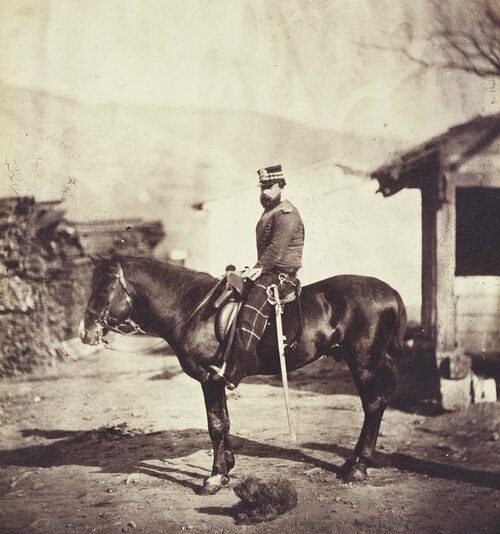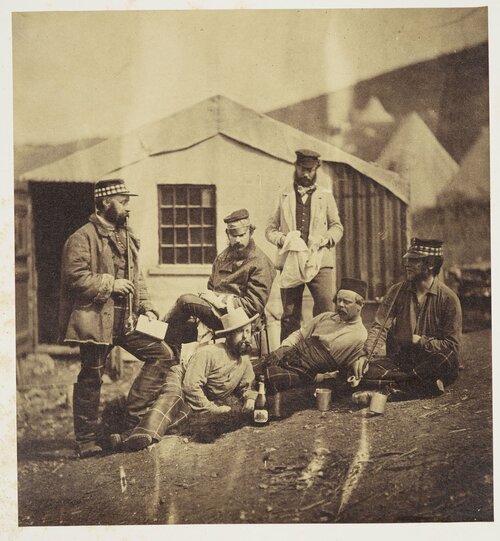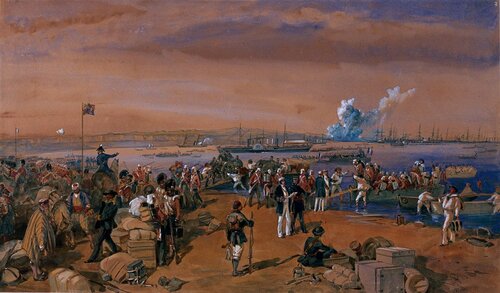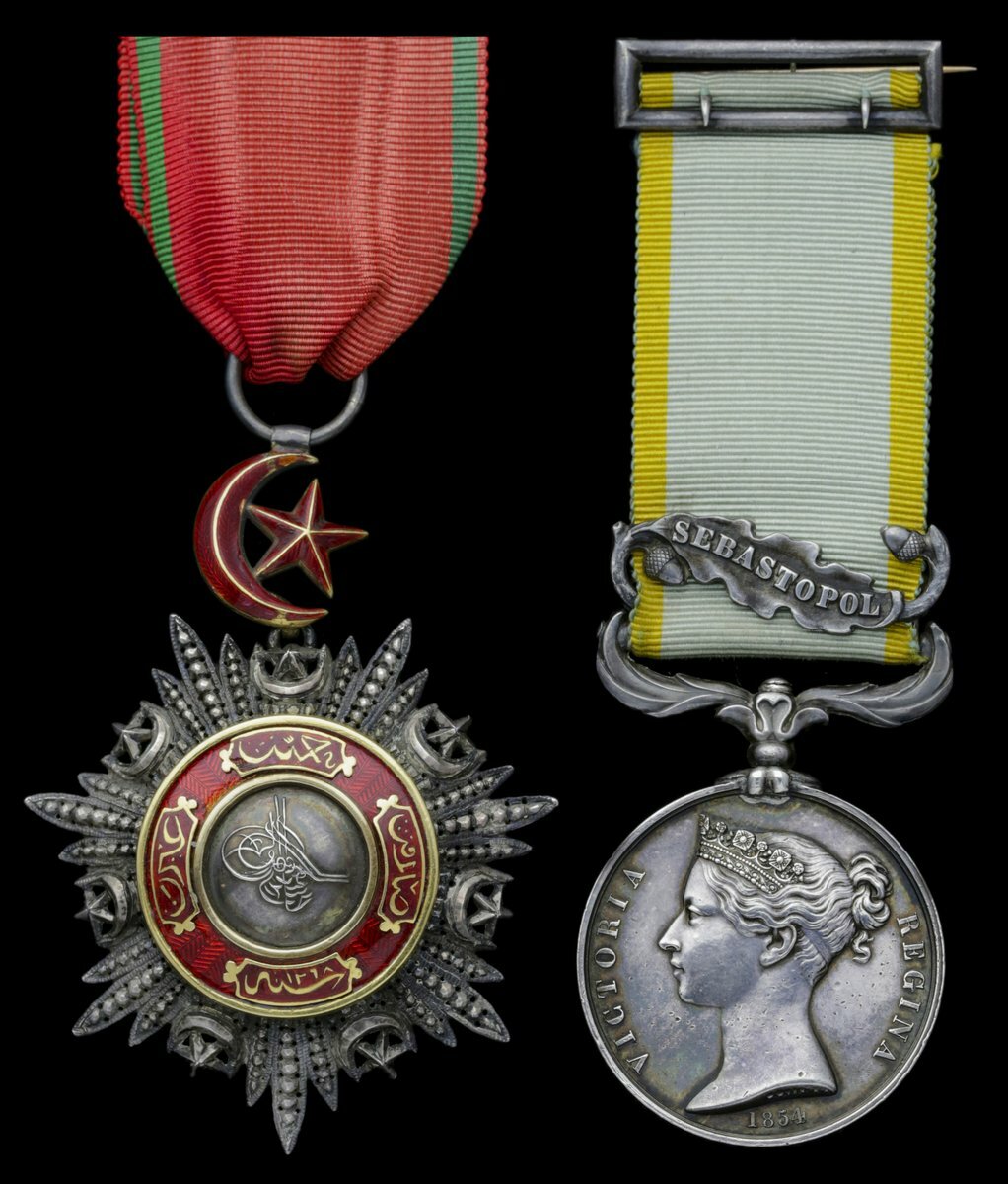Auction: 20003 - Orders, Decorations and Medals
Lot: 323
An outstanding Order of Medjidie and Crimea campaign pair awarded to Captain Viscount G. W. H. Fitzmaurice, Earl of Orkney, K.C.M.G., Scots Fusilier Guards, ADC to the Lord High Commissioner of the Ionian Islands and one of sixteen peers elected to represent Scotland in the House of Lords
Crimea 1854-56, 1 clasp, Sebastopol (Capt. Visct. Kirkwall. Scots. Fusilier. Guards.), Regimentally impressed naming, with silver buckle claw with gold pin; Turkey, Ottoman Empire, Order of the Medjidie, 5th class breast Badge (Viscount Kirkwall Scots Fus. Guards), engraved naming to reverse, fitted with gold pin and adapted suspension allowing wear as a Star, a little pitting, slight red enamel chipping, good very fine (2)
[K.C.M.G.] London Gazette 28 May 1875.
[Grand Commander of the Greek Order of the Redeemer] confirmed in The Dundee Courier and Argus
Order of the Medijie London Gazette 2 March 1858.
George William Hamilton Fitzmaurice was born in 1827, the eldest son of Thomas John Hamilton Fitzmaurice, 5th Earl of Orkney, and the Hon. Charlotte Isabella Irby. He was styled as Viscount Kirkwall until the death of his father in 1877, after which he become the Sixth Earl of Orkney.
He purchased a commission as an Ensign with the 92nd (Gordon) Highlanders in 1845 (London Gazette 8 August 1845, refers). At the start of his career the Regiment saw little action, however in 1851 they were posted to the Ionian Islands. These had been seized from the French during the Napoleonic War and had since been a British protectorate named the United States of the Ionian Islands. While Kirkwall did serve as a soldier here the bulk of his duties appear to have been more political in nature due to two appointments made during this time.
The first appointment was as Deputy-Lieutenant of Ayrshire (London Gazette 23 March 1852, refers), a role he presumably performed remotely particularly given his Regimental and administrative duties. He also served as the Aides de Camp to the Ionian High Commissioner, Sir Henry Ward. This positon was not without its troubles as Kirkwall himself relates in the two volume book he edited entitled Four years in the Ionian Islands; Their Political and Social Condition with a History of the British Protectorate. With the rise of an independent Greece the British rule, previously a preferable alternative to that of the Ottoman Empire began to chafe on the local population. Fortunately for Kirkwall he left the Islands for the Crimea before the crisis reached a head. Nevertheless Sir Henry Ward's tenure was marred with tension and even a minor revolt on Cephalonia. Interestingly Kirkwall was noted as being particularly popular among the Ionians and after the cession of the Islands to Greece he was granted an audience with the King. It seems likely that this was when he was made a member of the Order of the Redeemer.
In the course of this service with the 92nd he bought promotion as far as the rank of Captain (London Gazette 4 November 1853, refers). It may be that this reflects a certain restlessness of his part, for when the Crimean War broke out in October 1853 he swiftly arranged a transfer to the 71st Highlanders (London Gazette 23 December 1853, refers). While the 92nd Highlanders took part in the war they remained largely on garrison duties and received no battle honours. The 71st meanwhile were involved in operations around both Sebastopol and Kertch.
The 1st Battalion of the 71st arrived in the Crimea in early 1855 thus missing the earlier field engagements of Alma, Balaclava and Inkermann. They were kept at Balaclava in the hopes of forming part of an expedition to Kertch however this was delayed and instead they moved to the trenches of Sebastopol. Instead of finding the sort of glory a young aristocratic officer might have hoped for Kirkwall will have found a disturbing scene of trench warfare. The Siege had already lasted for eight months during which the army had suffered savagely from lack of provisions, terrible weather and disease.
Fortunately the regiment's brush with this stage of the war was to be brief. Later that month on 22 May they were pulled from the line for the renewed expedition to Kertch. This proved to be a success and the 71st continued to operate in this area until the end of the war; although a volunteer force of one hundred and twenty men did re-join the trenches alongside the Highland Brigade. Sebastopol fell in early September of that year after an exhausting year long siege and a peace treaty was concluded in March the following year.
This marked the highpoint of Fitzmaurice's military career, he transferred to the Scots Fusilier Guards in 1856 (London Gazette 25 January 1856, refers) and then the following year retired from the army. Not long after this, in 1858 he received his Order of the Medijie. Despite this ostensible retirement he appears to have joined the 2nd Royal Buckinghamshire Yeomanry, being listed as promoted from Lieutenant to Captain in 1860 (London Gazette 7 December 1860, refers).
In 1866 he was nominated a C.M.G. an appointment which caused no small amount of consternation from certain parties within the Order:
'Not only was Lord Kirkwall not of the class of officers to whom this distinction was ordinarily granted, but his connection with the Ionian Islands had long ceased, before they were annexed to Greece.' (The Order of St. Michael and St. George refers).
Nevertheless he was not only admitted but later elevated to a K.C.M.G. in 1875. In 1872 he married Amelia de Samuel, the widow of Baron David de Samuel though the couple never produced an heir and was as such his titles passed to his nephew.
In December 1885 he was elected one of the sixteen Scottish representative peers to sit in the House of Lords. Sadly he did not enjoy this position for long, dying just four years later on 21 October 1889. He is buried in Kensal Green Cemetery in accordance with his will.
The purchaser of this lot will also receive a digital copy of an extensive article published by Orders and Medals Research Society in summer 2020, written and researched by Owain Raw-Rees. This will include related medal rolls, background information on the family and obituaries of the recipient. This lot is also sold with a copy of a photograph by Roger Fenton (Royal Collection Trust - RCIN 2500271) taken in 1855 and a USB containing research material on the recipient and his brothers.
Subject to 20% VAT on Buyer’s Premium. For more information please view Terms and Conditions for Buyers.
Sold for
£1,400
Starting price
£900











